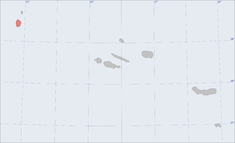Flores (Azores)
| Flores | |
| Island (Ilha) | |
|
Algoa Bay, the place where the original settlers disembarked and established their colony on the island of Flores, near Cedros
|
|
| Official name: Ilha das Flores | |
| Name origin: flores, Portuguese for flowers | |
| Nickname: Ilha Amarela | |
| Country | |
|---|---|
| Autonomous Region | Azores |
| Islands | Western Group |
| Location | Azores Platform, Mid-Atlantic Ridge, Atlantic Ocean |
| Municipalities | Lajes das Flores, Santa Cruz das Flores |
| Civil Parishes | Caveira, Cedros, Fajã Grande, Fajãzinha, Fazenda, Lajes das Flores, Lomba, Lajedo, Mosteiro, Ponta Delgada, Santa Cruz das Flores |
| Highest point | Pico do Burrinho |
| - location | Morro Alto, Santa Cruz das Flores, Santa Cruz das Flores |
| - elevation | 886.27 m (2,908 ft) |
| - coordinates | 39°28′0″N 31°13′38″W / 39.46667°N 31.22722°W |
| Lowest point | Sea level |
| - location | Atlantic Ocean |
| - elevation | 0 m (0 ft) |
| Length | 16.71 km (10 mi), North-South |
| Width | 12.26 km (8 mi), West-East |
| Area | 143 km2 (55 sq mi) |
| Biomes | Temperate, Mediterranean |
| Geology | Alkali basalt, Tephra, Trachyte, Trachybasalt |
| Orogeny | Volcanism |
| Period | Holocene |
| Demonym | Florense/Florentino |
| Ethnic groups | Portuguese |
| Population | 3,907 (2003) |
| Density | 27.32 /km2 (70.76 /sq mi) |
| Largest city | Santa Cruz das Flores (pop. 1,810) |
|
Location of the island of Flores in the archipelago of the Azores
|
|
Flores Island (Portuguese pronunciation: [ˈfloɾɨʃ]) is an island of the Western group (Grupo Ocidental) of the Azores. It has an area of 143 km², a population of approximately 3907 inhabitants, and, together with Corvo Island of the western archipelago, lies within the North American Plate. The nearby Monchique Islet is the westernmost point of Portugal. It has been referred to as the Ilha Amarelo Torrado (Yellow/Auburn Island) by marketing and due to the association with poet Raul Brandão, but it is well known for its abundance of flowers, hence its Portuguese name of Flores.
Some early accounts existed of the "(seven) islands of the Azores and two islands of Flores" (referring to the islands of Flores and Corvo), but no "official discovery" occurred until the mid-15th century. The island of Flores was discovered in the late summer of 1452 by the navigator Diogo de Teive and his son João de Teive, and first noted by the pilot Pêro Velasco to Christopher Columbus during his voyages. For his reward, Teive received the concession of the sugar monopoly on Madeira.
The earlier names of the island were São Tomás (after Thomas Becket of Canterbury, not to be confused with Saint Thomas, which in Portuguese is spelled Tomé) and Santa Iria (Saint Iria). The island's charter passed to Fernão Telles de Meneses when little was accomplished in populating the islands, except for disembarking some sheep (1475). The death of Fernão Telles (1477) was to initiate exploration and settlement on the island, as his widow (Dona Maria de Vilhena) would contract the Flemish nobleman Willem van der Haegen to explore Flores and Corvo.
...
Wikipedia



